Montana Historical Society Press
The Montana Historical Society Press publishes on the history of Montana, northern Plains, and Rocky Mountain history. We seek books that are well written, meticulously researched, and that make a significant contribution to the field of Western history.
Note: titles with an asterisk (*) are available as ebooks.
The Art of Charlie Russell
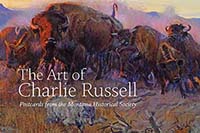
The Montana Historical Society's Charlie Russell collection represents the Cowboy Artist's most iconic works, from the earliest drawings sketched while working as a cowhand to his last masterpiece, left unfinished at the time of this death in 1925. The selection featured in this postcard booklet offers a sample of Russell's best-known oils, watercolors, letters, and sculptures, as well as photographs of the artist and his life. Each postcard is perforated; tear them out and mail them or keep them for your own enjoyment.
32 postcards, ISBN 978-1-940527-72-7, $12.95 Buy it now!
Autobiography of Red Cloud*
edited by R. Eli Paul
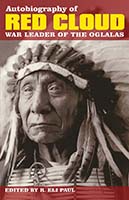
A brilliant military strategist, Red Cloud honed his skills against his tribe's traditional enemies—the Pawnees, Shoshones, Arikaras, and Crows—long before he fought to close the Bozeman Trail. Here is Red Cloud's "as-told-to" autobiography, where he shares the story of his early years. This manuscript brings us closer than the historical record has yet allowed to understanding the life of one of the greatest Lakota war leaders.
Beyond Schoolmarms and Madams*
edited by Martha Kohl

Beyond Schoolmarms and Madams presents the life stories of more than one hundred outstanding Montana women, from 19th-century Indigenous women warriors to 21st-century Blackfeet banker and activist Elouise Cobell. These biographical sketches celebrate the accomplishments of notable “firsts” in the political and professional realms as well as the extraordinary resilience of ordinary women surmounting tremendous obstacles. From commemorating the members of the Montana Federation of Colored Women's Clubs to recalling the women of the Ku Klux Klan, this book explores the diversity of women’s experiences, reaching across Montana’s rich geographical, cultural, and ideological landscape to share the stories of the remarkable women who shaped the Big Sky State.
Beyond Spirit Tailings*
by Ellen Baumler

Ellen Baumler has again traversed the state, interviewing and researching to present history with a ghostly twist. Her first book, Spirit Tailings, introduced Montanans to their haunted past. Beyond Spirit Tailings offers even more ghostly encounters from around the state, while Baumler branches out to explore such historical mysteries as the monster said to lurk in the deep waters of Flathead Lake, the power of an ancient object revered by Native peoples, and a possible explanation for the suspicious death of Thomas Francis Meagher. Richly embroidered with Montana's unique historical legacy, these eerie and mysterious tales will leave you looking over your shoulder, sleeping with the lights on, and always craving more.
Beyond Spirit Tailings (audiobook)
by Ellen Baumler and Philip Aaberg

Ellen Baumler's ever-popular historical ghost stories found an enthusiastic reader in world-famous composer Philip Aaberg. Inspired by these stories, Aaberg worked with Ellen to produce an audio version of Beyond Spirit Tailings to which he added music. Ellen and Philip's spooky collaboration will evoke those places and images that make our imagination such a wonderful (and sometimes unearthly) destination.
A Black Woman’s West
by Michael K. Johnson
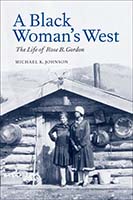
“Michael Johnson has found Rose Gordon’s voice, and all Montanans should applaud. Johnson presents the important Gordon family, and Rose’s own life and times, through her own words and in the context of Montana and the nation’s racial environment. The result is rare insight and marvelous reading—I came to love Rose, her words, and Johnson’s work.”
—Ken Robison, author of Cold War Montana and Historic Tales of Whoop-Up Country
“The story of a single life, well told, always amounts to more than the sum of its parts. Critically, Johnson allows the lives that Rose Gordon and her family led in White Sulphur Springs to stand on their own. But through Rose’s story, he recovers a much wider history of Montana’s society and culture that is seldom told. As a book meditating on race, belonging and the meaning of home, A Black Woman’s West has much to say to all students of Montana and Western history.”
—Anthony W. Wood, author of Black Montana
Born in the Barker mining district of central Montana Territory, Rose Beatrice Gordon (1883–1968) was the daughter of an African American chef and an emancipated slave who migrated to the West in the early 1880s. This book tells the story of the Gordon family—John, Anna, Robert, Rose, John Francis Jr., George, and Taylor—and pays tribute to Rose, who lived most of her life in White Sulphur Springs. In her youth, Rose excelled academically and distinguished herself as a musical performer. As an adult, she established her economic independence as a restaurant owner, massage therapist, and caregiver. She made a place for herself in the public sphere through letters to the editor and eventually through a regular newspaper column for the Meagher County News—a remarkable undertaking at a time when Black women in America were largely denied a public voice. As a Black woman in the West, Gordon led a life that was both ordinary in its day-to-day struggles and extraordinary in its sum.
Border to Border
by Annie Hanshew
introduction by Mary Murphy
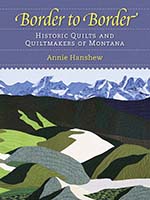
The quilts featured in Border to Border chronicle Montana’s history over the last 150 years, telling stories of statehood, women’s suffrage, two world wars, and the Great Depression, as well as sharing stories from the recent past. This heavily illustrated book showcases Montana’s unique and interesting quilts while describing the lives and times of the extraordinary people who created them.
“ Border to Border deftly and seamlessly stitches together the specifics of Montana’s history and the diversity of its women’s artistry. Lavishly illustrated and beautifully written, this book is a ‘must own’!”
—Janet Catherine Berlo, author of Quilting Lessons and Wild by Design
“ Border to Border is exactly what a quilt survey publication should be. Like a splendid antique quilt the book has bold impact, delicate detail and a story to tell. Dazzling quilts and first class photographs capture the history of a sprawling state with a variety of cultures.”
—Barbara Brackman, author of Encyclopedia of Pieced Quilt Patterns and Encyclopedia of Appliqué
Bound for Montana
edited by Susan Badger Doyle

On May 14, 1866, Perry Burgess summed up the expectations and hopes of countless westering Americans when he wrote in his diary: "packed up and started on our journey toward the land of gold." Here are stories of the prospectors, freighters, wives, and merchants who, like Burgess, traveled the Bozeman Trail in search of fortune, adventure, or a new life. A shortcut from the Platte River Road to the Montana goldfields, the Bozeman Trail was fewer than five hundred miles long, yet it has the enduring distinction of being the last great overland emigrant trail in the American West. Encounter the trail as it was experienced by seven travelers: the leader of a company of Michigan men who traveled with one of the first groups to cross it; a new bride journeying West with her husband; a store clerk and a typesetter on a thoroughly enjoyable adventure; a prospector seeking his fortune in the West; a sober Civil War veteran concerned about the possibility of Indian attack; and the supervisor of a freight train who found time to write despite his heavy responsibilities. Join their journey through these annotated diaries, and discover the pleasures and perils of traveling the Bozeman Trail.
Catastrophe at Custer Creek
by Ian Campbell Wilson
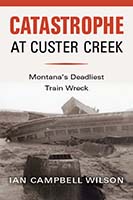
Just after midnight on June 19, 1938, the Olympian No. 15, an elite passenger train operated by the famed Milwaukee Road, crashed into Custer Creek southwest of Terry, Montana. In the moments before the train reached the small bridge spanning the typically dry creek, the waters had swelled dramatically, the result of a violent storm system. The wreck killed forty-nine passengers and crew members and injured seventy-five, making it the most devastating train accident in Montana history.
Catastrophe at Custer Creek documents the final ride of the Olympian. In this vivid narrative history, Ian Campbell Wilson reconstructs the lives of passengers and crew members, probes what caused this unprecedented disaster, and surveys the intertwined histories of the Milwaukee Road and the eastern Montana communities that the Olympian passed through on its route from Chicago to Tacoma.
Charlie Russell Roundup
edited and with an introduction by Brian W. Dippie
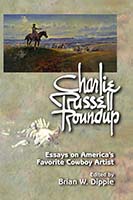
Illustrated with both color and black-and-white illustrations—including a never before reproduced Russell painting— Charlie Russell Roundup contains many of the best stories and critical thinking on Russell, an artist who portrayed the Old West in all its vibrancy. Early press accounts of the cowboy artist, reminiscences by his friends and fellow artists, interpretive and biographical studies, and a few words from Russell himself are all included in this engaging anthology. Fresh insights into the man and his art, and his enduring legend are enhanced by historic photographs and a large sampling of Russell's work.
Brian W. Dippie is Professor of History at University of British Columbia, Victoria, editor of Charles M. Russell, Word Painter, and author of Looking at Russell and West-Fever, as well as many other books.
Christmastime in Montana
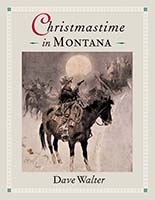
An entertaining assortment of Christmas memoirs, newspaper accounts and editorials, poems, and menus collected from the vast archives of the Montana Historical Society, Christmastime in Montana connects readers to the state's rich and varied history through celebrations of Christmas day. From shoot-outs and dances in Virginia City to high society celebrations at a luxurious Billings hotel, Christmastime in Montana examines nearly two centuries of Montanan's observances of this special day. Spend Christmas with Montana's early prospectors, ranchers, and homesteaders, and learn how Montanans came together to make Christmas merry and bright. Containing handsome historic photographs and illustrations, Christmastime in Montana is a great way to share Christmas history with all Montanans and Montanans at heart.
Conveniences Sorely Needed*
by Jon Axline
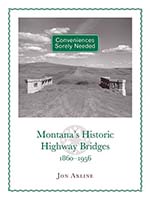
Old bridges do more than just span rivers. They provide an important historical connection between the hopes and dreams of the people who built them and those who continue to benefit from their use today. Montana's historic highway bridges are symbols of the cooperative spirit that led to the economic and social stability of communities throughout the Big Sky Country for over a century. Other bridges, such as those built during the Great Depression, are physical reminders of significant periods in American history and tell stories about the breadth of Montana's transportation past. All are representatives of the best in engineering practices and serve as testament to the science of bridge design. From the aesthetically delightful Fort Benton Bridge to the utilitarian Fred Robinson Bridge in the Missouri Breaks Country, Montana's bridges signify the best in American bridge engineering. Today, Montana's bridges are a visible, often overlooked, and fast disappearing part of the state's historic landscape, yet the story they tell is significant to understanding the dynamics of Montana's development in the nineteenth and twentieth centuries and the optimism many had in its future.
paper, ISBN 978-0-9721522-6-6, $22.00; cloth, ISBN 978-0-9721522-5-9, $39.95 Buy it now!
Copper Chorus
by Dennis Swibold
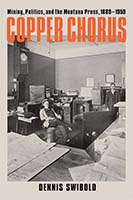
Copper Chorus is the colorful story of how a ruthless mining company secretly bought control of Montana's major daily press—and eventually gave it up. Swibold uncovers the costs paid by newspaper owners and journalists, whose credibility eroded as their increasingly constricted newspapers lapsed into ambivalence and indifference. The story offers a timeless study of the conflict between commerce and the notion of a free and independent press.
Cowboy Trout*
by Paul Schullery
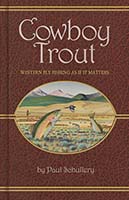
In Cowboy Trout, historian-angler Paul Schullery chronicles great moments in western fly fishing, from the adventures of pioneer anglers casting the first flies on pristine mountain streams to the unexpected modern emergence of fly fishing as a Western political, commercial, and even spiritual endeavor.
Coyote Stories of the Montana Salish Indians
Developed by the Salish Culture Committee, Confederated Salish and Kootenai Tribes
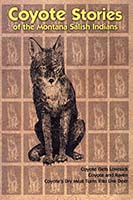
The Salish Cultural Committee presents three lively Coyote tales—"Coyote Gets Lovesick," "Coyote and Raven," and "Coyote's Dry Meat Turns into Live Deer"—in this delightful book in the Indian Reading Series. The Salish people of the Flathead Indian Reservation have long used stories, including stories about Coyote the trickster, as teaching tools. Illustrated with pen-and-ink drawings, and written at a fourth-grade reading level, these ancient Coyote stories are now available to a new generation of children everywhere. Copublished with Salish Kootenai College Press.
Evelyn Cameron's Montana
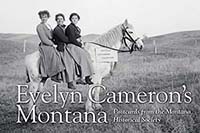
Born to a wealthy British family, Evelyn Cameron came to eastern Montana in 1893 to raise polo ponies and over the course of three decades photographed her friends, family, and neighbors. Cameron's distinctly candid photographs capture the daily and seasonal rhythms of agrarian life, revealing the community spirit, playfulness, and hard work of Montana's homesteaders. Each postcard is perforated; tear them out and mail them or keep them as souvenirs of your own Montana experience.
Frontier Soldier* (ebook)
by William F. Zimmer
edited by Jerome A. Greene
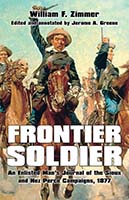
"Not many enlisted men recorded their adventures in Indian warfare. Still fewer actually kept a journal to lend immediacy to their observations. Frontier Soldier is such a journal, by a literate private who left his story of plains warfare in a chronicle rich in detail. It is the richer for the annotations of Jerome A. Greene, whose understanding of the campaigns in which Zimmer marched is surpassed by few historians."
—Robert M. Utley, author of Cavalier in Buckskin: George Armstrong Custer and the Western Military Frontier
Girl from the Gulches*
as told to Margaret Ronan
edited by Ellen Baumler
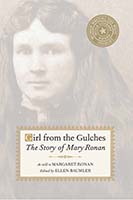
"One of the most important personal recollections of Montana's mining frontier."
—Mary Clearman Blew, author of Bone Deep in Landscape
A covered wagon on a dim road, the promise of a long journey, and the wonder of what lay ahead filled the shadowy spaces of Mary Sheehan Ronan's earliest memories. By the time she was a married woman in her twenties, Mary was a well-seasoned pioneer, having crossed most of the country and retraced her steps back across a third of it. This detailed memoir recounts a girl's growing up on territorial Montana's mining frontier, her ascent to young womanhood on a farm in southern California, her experiences as a student in a Los Angeles convent school, her return to Montana as a bride, and her life on the Flathead Indian Reservation as wife of an Indian agent. Ronan describes with vivid clarity the exhilaration of a forbidden sled ride, the creaking of the hangman's rope, and her father giving the last of their water to his dying mule. A highly entertaining account of one pioneer woman's life in the West during the nineteenth century, Girl from the Gulches is a joy to read.
A Guide to Historic Glendive
by Montana Historical Society
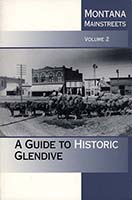
Rooted in the railroad and ranching industries, Glendive, Montana, lies in the lower Yellowstone Valley about thirty miles from the North Dakota border. First and foremost a railroad town, Glendive's development and architecture reflect its Northern Pacific heritage and the spirit of its residents. Discover the history of "Gate City" of the Yellowstone Valley in this lively guide to Glendive's historic buildings.
A Guide to Historic Hamilton
by Chere Jiusto
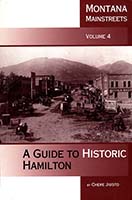
Founded in 1890 against the backdrop of the lush Bitterroot Valley, the town of Hamilton emerged with the growth of western Montana's timber, railroad, and agriculture industries. Hamilton owes its early history to copper baron Marcus Daly, whose Anaconda Company sawmill and private Bitter Root Stock Farm dominated the community through the late nineteenth century. The drama of the twentieth-century apple boom and the saga of the battle to find a cure for Rocky Mountain tick fever enrich the town's more recent past. Offering detailed architectural and historical insights on the buildings and historic sites of both Hamilton and the surrounding Bitterroot Valley, this informative guide will entice readers to explore "the jewel of the Bitterroot."
A Guide to Historic Kalispell
by Kathryn McKay
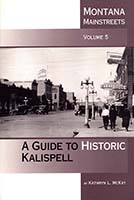
Founded in 1891 as a railroad town for the transcontinental Great Northern Railway, Kalispell, Montana, faced bitter disappointment when the railroad relocated its route to the north in 1904. Most towns suffering similar fates fell into decline, but not Kalispell. Designated the Flathead County seat in 1894, Kalispell—named for the region's Q’lispé tribe—retained its status as regional center of trade and grew to become a gateway to Glacier National Park. Discover the fascinating history and architecture of this leading town of northwest Montana.
A Guide to Historic Lewistown
by Ellen and Ken Sievert
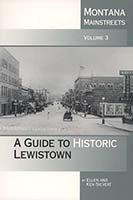
In the geographic center of Montana sits Lewistown, the seat of Fergus County. Founded in the 1870s by Métis traders, Lewistown grew rapidly during the homesteading boom. Its population tripled between 1900 and 1910, then doubled again by 1920, as this advantageously located rail stop and commercial center expanded to become the thriving hub of central Montana. The architectural heritage of Lewistown awaits your discovery.
A Guide to Historic Missoula* (ebook)
by Allan James Mathews
Winner of a Certificate of Commendation from the American Association for State and Local History
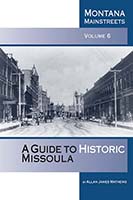
Situated west of the Continental Divide, the town of Missoula got its start in 1860 as a trading post called Hellgate, supplying miners with produce, flour, other trade goods, and lumber. Missoula's designation as county seat in 1866 and the arrival of the Northern Pacific in 1883 and the Milwaukee Road in 1909 cemented the town's role as a center of commerce. Its economy diversified further when Missoula became home to the state university—now called University of Montana—in 1895 as well as the U.S. Forest Service's regional district headquarters for the Rocky Mountains in 1908. With a flourishing downtown district and well-preserved historic homes, Missoula's streetscapes today reflect the town's abundant history, thanks, in part, to a successful historic preservation program that has protected much of the community's rich architectural legacy. Explore Missoula's buildings, parks, and historic sites through this guide.
A Guide to Historic Virginia City* (ebook)
by Marilyn Grant
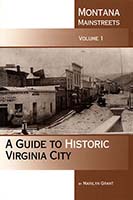
The gold-rush town of Virginia City, purchased by the State of Montana to preserve for posterity, makes a fitting first subject for the Montana Mainstreets series. Historic Virginia City was Montana's second territorial capital and the center of trade for Alder Gulch, the site of the richest placer mines in the world during the 1860s. When the gold deposits played out and the state capital moved to Helena in 1889, Virginia City became frozen in time. Today, Virginia City attracts visitors from all over the world, who marvel at its intact frontier architecture and the seeming immediacy of the gold rush era. If walking down Virginia City's streets is like a trip back in time, the road map for that journey is Guide to Historic Virginia City.
A History of Montana in 101 Objects
edited by Kirby Lambert
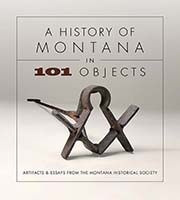
Since 1865, the Montana Historical Society has pursued its mission to collect and protect items of significance to Montana’s past for the pleasure and education of residents and visitors. A History of Montana in 101 Objects showcases the remarkable collection of artifacts preserved at the Montana Historical Society. This assemblage of objects and interpretive essays, accompanied by beautiful photographs by MHS photographer Tom Ferris, draws attention to the diversity of experiences—the triumphs and the sorrows, the everyday struggles and joys—that made Montana.
ISBN 978-1-94052-796-3, $29.95
The History of the Assiniboine and Sioux Tribes of the Fort Peck Indian Reservation, Montana, 1600–2012
by David Miller, Dennis Smith, Joseph McGeshick, James Shanley, and Caleb Shields
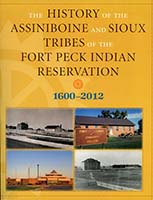
The first comprehensive history of the Fort Peck Indian Reservation commissioned by the tribes themselves, The History of the Assiniboine and Sioux Tribes of the Fort Peck Indian Reservation, 1600–2012 is an authoritative scholarly exploration of the struggles and triumphs of the Native Americans who were relegated by the federal government to a reservation in northeastern Montana in the late 1880s. Written by five scholars of Native American Studies,including tribal members, the narrative traces Assiniboine and Sioux tribal history from pre-contact with whites through the brutal early reservation period, two world wars, the turbulent 1960s, and into the 21st century. Drawn mostly from primary sources, including federal archives and private materials, this book is a benchmark in the publication of tribal histories with a native point of view. Copublished with Fort Peck Community College.
Hope in Hard Times*
by Mary Murphy
Winner of the 2003 Montana Book Award
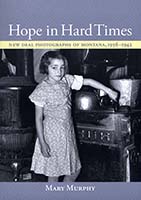
In the 1930s and 1940s, four Farm Security Administration photographers were detailed to Montana to document the effects of the Great Depression on the state. Traveling throughout the state, Arthur Rothstein, Marion Post Wolcott, Russell Lee, and John Vachon captured the many ways the Depression altered Montana's rural and urban communities, changed its agricultural and industrial economies, and affected the work and play of its residents. Rothstein, Wolcott, Lee, and Vachon's photographs are both stunning pieces of art and important historical documents. Today these striking images present an unforgettable portrait of a little-studied period in the history of Montana, documenting both the hardships Montanans experienced and their faith in a brighter future. Selected from the FSA Collection at the Library of Congress in Washington, D.C., the photographs in Hope in Hard Times offer viewers an unparalleled look at life in Montana in the years preceding the United States' entry into World War II.
How Marten Got His Spots and Other Kootenai Indian Stories
illustrated by Debbie Joseph Finley and Howard Kallowatt Jr.
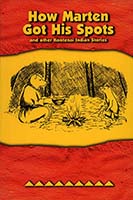
Recorded by Kootenai elders and illustrated by Kootenai artists from the Flathead Indian Reservation in western Montana, these Kootenai stories were originally intended to help educate young tribal members about their history and culture. The collection includes "How Marten Got His Spots," in which Marten learns a hard lesson in obedience; "Coyote and Trout," in which Coyote discovers the consequences of greed; "Little Weasel's Dream," in which a child learns the importance of listening to his elders; and "Tepee Making," an illustrated lesson in tepee construction. For centuries, Kootenai children and adults gathered on cold, dark winter nights to share and learn from stories like these. Co-published with Salish Kootenai College Press.
How the Morning and Evening Stars Came to Be and Other Assiniboine Indian Stories
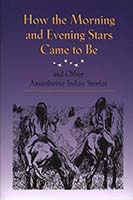
As part of the Indian Reading Series, a collection of authentic material cooperatively developed by Indian people, How the Morning and Evening Stars Came to Be offers three explanatory and cautionary tales from Montana's Assinboine people. Recorded by Assiniboine storytellers and illustrated by Assiniboine artists from the Fort Peck and Fort Belknap Indian Reservations, these traditional tales have been handed down for generations and were designed to teach youngsters the tribe's history and culture. These lively and engaging stories will appeal to anyone who is interested in exploring the world of the Assiniboines. Co-published with Fort Peck Tribal Library.
I Do
by Martha Kohl
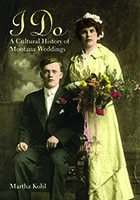
Weddings make for great—and sometimes startling—stories: the woman who escaped from her bedroom window to run off with a neighboring rancher; the priest who planned to combine an eighth-grade graduation ceremony with a wedding mass; the couple who courted for years by mail before managing to overcome the vast distance that separated them; the wedding guests who played cards while waiting for the bride’s grandparents to arrive on a delayed train; the mail-order bride who jilted the man who sent for her; the couple who married on the main pavilion of the 1905 Flathead County Fair; the couple who exchanged their vows at a Great Falls gun show.
Through stories like these, I Do tells of weddings as diverse as the couples who have lived and married in Montana: Finnish homesteaders, Chinese restaurateurs, Métis fiddlers, Irish miners, Blackfeet students, and Jewish merchants. But whether the brides and grooms said "I do" in a cathedral or an isolated cabin, in 1860 or one hundred years later, their stories offer a unique—and intimate—view to Montana's past.
hardcover, ISBN 978-0-980129-21-2, $34.95; paper, ISBN 978-0-980129-22-9, $22.95 Buy it now!
"I Will Be Meat for My Salish"
by Bon I. Whealdon, et al.
edited by Robert Bigart
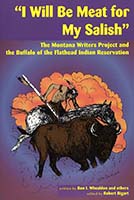
The story of the Salish people's relationship to the buffalo—including their role in protecting the species—is preserved in this collection, which includes all extant interviews by the Montana Writers Project with Salish elders from the Flathead Reservation. This well-rounded book offers bison-related cultural legends, discussion of traditional lifeways, and biographies of important figures on the reservation, offering a glimpse into tribal life as it was lived in the nineteenth and early twentieth centuries and reinforcing the significance of bison to Montana's Salish people. Co-published with Salish Kootenai College Press.
Jeannette Rankin, America's Conscience*
preface by Joan Hoff
introduction by Kathryn Anderson
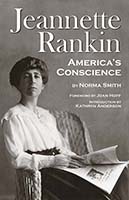
Suffragist, social worker, lifelong peace activist, and tireless advocate for political reform, Jeannette Rankin is often remembered as the first woman elected to the United States Congress and as the only Congressperson who voted "no" to U.S. involvement in both world wars. Rankin's determined voice shines in this biography, written by her friend, Norma Smith.
Legacy
edited by Charles E. Rankin
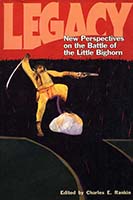
In this collection of essays from the 1994 Little Bighorn Legacy Symposium, an outstanding array of scholars discuss the battle's context, historical significance, and cultural impacts from both white and Native American perspectives. Contributors include Richard A. Fox, Jr., Paul Andrew Hutton, Edward T. Linenthal, and Richard S. Slotkin. Essays examine such diverse topics as the environmental context of the northern plains, new archaeological discoveries about the battle, how Custer has been portrayed in art and the movies, and the battle's symbolic legacy.
Mary Quequesah's Love Story: A Pend d'Oreille Indian Tale
by the Salish Culture Committee, Confederated Salish and Kootenai Tribes
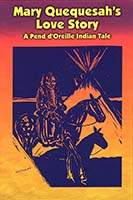
In Mary Quequesah's Love Story, a tale from the buffalo-hunting era of the nineteenth century, a young woman confronts the difficulties of love. After Mary's husband leaves her, a wise old woman dreams of Mary's sorrow and tells her how to win him back.
Elegant woodcuts by noted Native American artist Dwight Billedeaux accompany this complex story, which, while written at a fifth-grade reading level, will speak to readers of all ages. Co-published with Salish Kootenai College Press.
Mining Childhood*
by Janet L. Finn
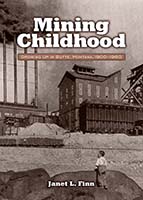
Mining Childhood offers a child’s-eye view of Butte, Montana, from 1900 to 1960, the six decades marking Butte’s fame as the “Richest Hill on Earth.” The biographical stories presented here remind us that children were not sheltered from the "adult" world around them; rather, they were shapers of that world. Children were keen observers and active participants in community life, and their accounts of work, play, family, schooling, ethnicity, and neighborhood life offer fresh perspectives on Montana's mining city in all its complexity.
Montana: A Paper Trail
foreword by Brian W. Dippie

“In this sumptuous book, Tom lays his treasures out before our eyes, and provides the context necessary to understand the claim each holds on his attention.”
~Brian Dippie, historian and author
“Rarely does a private collection of this caliber become accessible to the public; even rarer is to have the objects so skillfully and enjoyably explained, as Minckler does in Montana: A Paper Trail.”
~Diana Di Stefano, editor, Montana Historical Society Press
“Make no mistake, this is the finest gathering of Montana source material ever brought together.”
~Nathaniel Des Marais, veteran Western Americana specialist
Collector and historian Thomas Minckler spent a half century gathering nineteenth- and early-twentieth-century letters and documents, vintage photographs, rare books, and paintings. He shares these collections in Montana: A Paper Trail.
Minckler’s decades of researching and contextualizing items in his collection uncovered innumerable valuable insights on Montana history. Each artifact’s unique paper trail reveals a journey that contributes to the fascinating story of Montana.
The wide-ranging collection includes the sole image of James Kipp (1788–1880), the iconic builder of Upper Missouri River fur trading posts. It also includes photos of the legendary Ferdinand Hayden’s Yellowstone Expedition in 1871 taken by Bozeman photographer Joshua Crissman, who produced the first images of Yellowstone Park and the only known photo of the Expedition’s wagon train. In addition, the collection includes outstanding unpublished material by Granville Stuart, Teddy Blue Abbott, Charles M. Russell, Thomas Meagher, Father Pierre DeSmet, and George Armstrong Custer.
Montana Moments (ebook)*
by Ellen Baumler
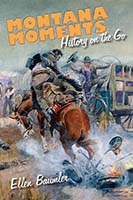
“The pages of Montana Moments overflow with enjoyable historical vignettes that cover nearly everything important that’s happened in Montana’s history. Newcomers will find an excellent introduction to what makes Montana tick, while Baumler’s careful research and entertaining writing style will delight old-timers.
—Harry Fritz, University of Montana, Missoula
Forget dreary dates and boring facts. Montana Moments distills the most interesting, funny, and even bizarre stories from Montana’s history into pure entertainment. Meet the colorful cast of famous and not-so-famous desperadoes, vigilantes, madams, and darned good men and women (and a few critters) who peopled the state’s history. You’ll get a laugh from the transient vaudevillian who wrote the state song, while Captain James C. Kerr’s tale of the Flathead Lake monster might make you shiver. No matter your reaction, you’ll have fun exploring Montana's past.
Montana Native Plants & Early Peoples
by Jeff Hart
Illustrated by Jacqueline Moore
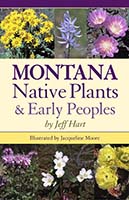
From Alder to Yellowbells, sixty native Montana plants are featured in this fascinating and informative guide, now in a new, easy-to-use format. Learn how Indigenous people and early settlers of the Rocky Mountain West used these native plants for food, medicine, and religious rituals. Each illustrated entry also gives a detailed description of the plant and its habitat and range.
Montana Place Names from Alzada to Zortman
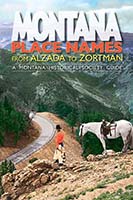
Montana Place Names from Alzada to Zortman explores the origins of more than 1,200 place names in the Big Sky State. Written by Montana Historical Society staff and drawing on the expertise of historians from around the state, this book includes detailed descriptions of towns and cities, geographic features, parks and battlefields, properties on the National Register of Historic Places, and more. A full-color map and extensive index help readers to locate each place, and historic images reveal the Montana of yesteryear.
Montana's Charlie Russell
by Jennifer Bottomly-O'looney and Kirby Lambert
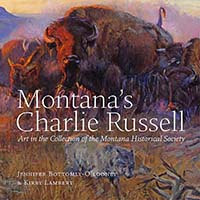
Montana’s Charlie Russell brings to life the Montana Historical Society’s world-class collection of paintings, drawings, sculptures, bronzes, and illustrated letters by the Treasure State’s famed Cowboy Artist. Using advanced digital technology, each of the 230 pieces in the Society’s permanent collection has been meticulously photographed to bring to life, in vivid color, Russell’s artistic mastery. Carefully researched scholarship illuminates the stories behind each artwork. The result is a catalog of Russell’s art as you’ve never seen it before!
Cloth, ISBN 978-1-940527-10-9, $80.00 Buy it now!
Leather-bound collector's edition, ISBN 978-1-940527-70-3, $250.00 Buy it now!
Montana's Historical Highway Markers (ebook)*
by Jon Axline
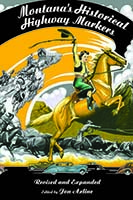
Remarkable stories from Montana’s historical highway markers combine with easy-to-follow maps, historical photos and sketches, and geological information to illuminate the paths of Montana’s past and present. This guidebook alerts travelers about places that merit a stop and allows them to read about the site at their leisure. Travelers can refer to descriptions and historical photographs to learn about Montana’s past as they journey across the state.
Montana's State Capitol
by Kirby Lambert, Patricia M. Burnham, and Susan R. Near
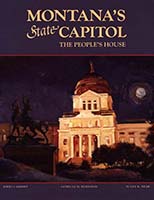
An imposing symbol, Montana's Capitol reflects the values and aspirations of the Treasure State's founders. Its neoclassical design echoes the architecture of early Greece and Rome, while the murals and statues that embellish the building's grand interior spaces commemorate important events and people in the state's history. Lavishly illustrated with both historic and modern photographs, Montana's State Capitol: The People's House provides a long overdue tribute to the crown jewel of Montana architecture. Essays explore the construction of the Capitol and the creation of the sculpture and murals that adorn its halls, including one of artist Charles M. Russell's most admired works. Published to honor the building on its centennial anniversary, Montana's State Capitol will provide readers with a fresh appreciation for this "Temple of Democracy."
Montana: Stories of the Land
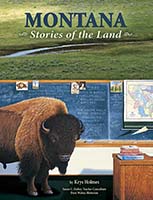
"Montana: Stories of the Land includes the 'Indian side of the story.' It offers Indians' perspectives not just on the settlement era of Montana history, but on the Depression, World War II, and the 1972 Constitutional Convention. . . . This text tells all the stories of the land."
—Professor Walter C. Fleming, Chair of the Native American Studies Department, MSU
Accurate, inclusive, engaging, and up-to-date, Montana: Stories of the Land is the ideal Montana history textbook for 7th and 8th grade. Reviewed by both content experts and classroom teachers, this abundantly illustrated book is aligned to Montana Content Standards for Social Studies and the Essential Understandings regarding Montana Indians. The MHS Education program offers an online teaching companion with extension lessons.
Montana's Visionary Mayor: Willard E. Fraser

“As Lou Mandler’s sprightly written, extensively researched biography reveals, Fraser was the rare politician: a hard-working, imaginative visionary with pragmatic flexibility. He rightfully claims the title as ‘Billings’s greatest mayor.’ ”
~Keith Edgerton, MSU–Billings
Willard Edward Fraser (1907–1972) was the progressive and often controversial four-term mayor of Billings, Montana, during the turbulent 1960s, but his reach and impact lay far beyond the borders of the Magic City. A true humanitarian, Fraser was equally comfortable rubbing elbows with high-level politicians and celebrities—like his father-in-law, poet Robert Frost—and hobnobbing with the “bums” on Skid Row. He tackled air and water pollution, cleaned up urban blight, and ensured that women, youth, and ethnic minorities were not marginalized. Passionate about Montana’s historical and cultural heritage, Mayor Fraser promoted Billings and Montana to the world.
More Montana Moments*
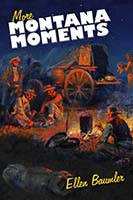
When Evelyn Cameron first rode into Miles City in the dark blue divided riding skirt she had ordered from California, oh, the scandal it caused. Ellen Baumler tells that story and more in this expanded volume of the most funny, bizarre, and interesting episodes from Montana’s history.
Nez Perce Summer, 1877* (ebook)
by Jerome A. Greene
foreword by Alvin M. Josephy, Jr.
Winner of 2001 Eastern National Authors Award

Written by one of the foremost experts in frontier military history and reviewed by members of the Nez Perce Tribe, Nez Perce Summer, 1877 details the dozen armed encounters between U.S. Army troops and a desperate body of Nez Perces during the tension-filled summer of 1877. A meticulously researched narrative, this definitive history of the Nez Perce War chronicles a people's epic struggle to survive spiritually, culturally, and physically in the face of unrelenting military aggression. Sixteen maps detail troop and Indian movements and skirmishes, while forty-nine photographs further illuminate this dramatic conflict.
Over a Century of Moving to the Drum
by Johnny Arlee
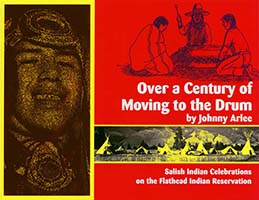
For more than one hundred years, the Arlee Fourth of July Celebration, or Powwow, on the Flathead Indian Reservation has brought people together to honor the traditions of the Salish. Over a Century of Moving to the Drum: Salish Indian Celebrations on the Flathead Indian Reservation, by Salish teacher and spiritual advisor Johnny Arlee, offers a tribute to this longstanding community event. Lavishly illustrated with pen and ink sketches of powwow scenes and photographs of powwows in the 1940s, the main narrative is based on interviews Arlee conducted with Salish elders in the 1970s. Excerpts of the interviews—and interviews with modern powwow participants—round out the volume. Copublished with Salish Kootenai College Press.
People Before the Park*
by Sally Thompson, Kootenai Culture Committee & Pikunni Traditional Association
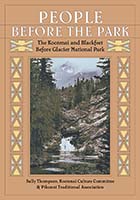
Step into the world of the Kootenai and Blackfeet peoples, whose traditional territories included the area that is now Glacier National Park. In this book, the Kootenai and Blackfeet Tribes share their traditions—stories and legends, foodways and hunting techniques, games and spiritual beliefs. Readers will discover the rich history of the people who called the Crown of the Continent home.
The Quest
by Richard S. Buswell
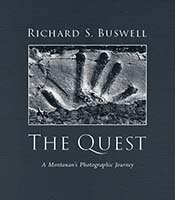
The Quest showcases seventy-one arresting photographs by Dr. Richard Buswell. This powerful collection brings readers into an evocative and contemplative space, where images of deteriorating past are captured to bring out their hidden beauty. The abandoned material things of everyday life take on new energy through his camera lens, strange and wonderful. This is a journey into a world suspended between a receding past and the magical present.
Ghost towns can have an eerie allure or architectural charm, but Buswell’s technique captures more than decrepit buildings and historic trash. Recently, the Montana Historical Society acquired Buswell’s complete oeuvre as part of its permanent collections. In celebration of his work, Montana Historical Society Press and the University of Montana Press have partnered to publish this stunning book.
The Red Corner*
by Verlaine Stoner McDonald

The Red Corner chronicles the meteoric rise and decline of Communism on the prairies of northeastern Montana. During the 1920s and early 1930s, Sheridan County boasted a government largely run by Communists, a Communist camp for local youth, and an official newspaper of the Communist Party USA—the Producers News. By the mid-1930s, however, Communist influence in the region had waned, and area residents soon came to regard the county’s embrace of Communism as a shameful period in its history.
Through meticulous research in newspaper accounts, oral histories, FBI reports, and internal Communist Party files, author Verlaine Stoner McDonald reveals the colorful stories of such influential local Communists as newspaper editor and state senator Charles E. “Red Flag” Taylor and his comrade, county sheriff Rodney Salisbury, who was allegedly involved in graft, prostitution, and bootlegging. In so doing, she offers insights into how this remote part of the northern plains came to be home to one of the nation’s most successful rural Communist organizations and how it eventually rejected radicalism and reconstituted itself as a typical farming community.
Searching for Yellowstone*
by Paul Schullery

"In Searching for Yellowstone [Schullery] has given us a refreshingly unhyperbolic look at the place he loves, and has thus notably honored its beauty, its mystery, its people, its past—and its future."
—New York Times Book Review
Searching for Yellowstone: Ecology and Wonder in the Last Wilderness traces Yellowstone's social and ecological history from the Pleistocene to the present in a seminal work that the press is pleased to bring back into print.
Paul Schullery, the former director of the American Museum of Fly Fishing, is the author of Lewis and Clark among the Grizzlies (2002) and coauthor with Lee Whittlesey of Yellowstone's Creation Myth (2003).
Buy the ebook: Kindle | iBooks | Nook | Kobo
Spirit Tailings*
by Ellen Baumler

If ghosts are the restless spirits of those who died violently or suddenly, then Montana's turbulent frontier history offers a rich setting for these haunting stories. This wonderful collection—based on oral testimony, diaries, journals, and newspaper accounts—presents an eerie history of the state's legendary mining towns. In addition to their ghoulish intrigue, these stories combine to provide new perspectives and a great appreciation for Montana's past.
A Tenderfoot in Montana*
by Francis M. Thompson
edited by Kenneth N. Owens
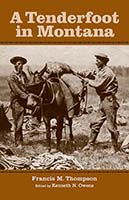
Frank Thompson's lively memoir details his experiences in the upper Missouri country at the beginning of the Montana gold rush. A young man at the outset of the Civil War, Thompson supported the Union cause but realized that military life was not for him. Turning to the frontier, he headed west from St. Louis in 1862, arriving aboard the first steamboat ever to reach Fort Benton, in what would later become Montana Territory. Thompson's sojourn was relatively brief—he returned east after only two and a half years. But in that time he hunted for gold, ran a Bannack City mercantile business, traveled to the Pacific Coast and back, served in Montana's first territorial legislature, and became a speculator in mining properties.
Thompson also formed a relationship with controversial sheriff Henry Plummer. Thompson knew the sheriff well, but he was suspicious of the gold camp lawman. Drawing from his intimate knowledge of the circumstances and players involved, Thompson vividly describes one of the deadliest incidents of vigilantism in U.S. history.
A self-styled tenderfoot, Frank Thompson recalls his days on the mining frontier with clarity and insight, making him an unmatched eyewitness to Montana's formative era.
A specialist in western history, Ken Owens is also the editor of Perilous Passage: A Narrative of the Montana Gold Rush by Edwin Ruthven Purple (Montana Historical Society Press, 1995) and a frequent contributor to Montana The Magazine of Western History.
Ties, Rails, and Telegraph Wires
by Dale Martin
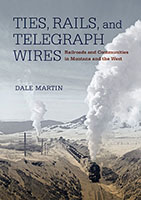
Railroads brought more to Montana and the West than passengers and a fast way to get back to “civilization.” The coming of the “iron horse” invigorated existing towns, created new ones, and generated employment on the railroads and in the communities through which they passed. Ties, Rails, and Telegraph Wires provides a window into the lives of the laborers, engineers, firemen, conductors, water tank operators, station agents, telegraphers, and section crews, as well as the town folk and rural residents who came to count on the railroads for employment, transportation, shipping freight, sending mail, and more. Heavily illustrated with dozens of railroad-related historic photographs, the book includes stories about the railroads told by Western writers such as Ivan Doig, Mary Clearman Blue, and Alice Munro. Let Ties, Rails, and Telegraph Wires put a face and a place to “Waiting for a Train.”
paper, ISBN 978-1-940527-92-5, $19.95
Traveler's Guide to the Great Sioux War* (ebook)
by Paul L. Hedren
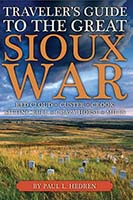
Fueled by the glitter of Black Hills gold, the Great Sioux War of 1876–1877 transformed the vast northern plains from Indian and buffalo country to the domain of miners, cattlemen, and other settlers. Keyed to official highway maps, this richly illustrated guide leads the traveler to virtually every principal military landmark associated with the war, from Fort Phil Kearny where the Sioux besieged soldiers sent to guard the Bozeman Trail in the 1860s to Fort Buford, the site of Sitting Bull's surrender in 1881.
Treasure State Tycoon
by John C. Russell
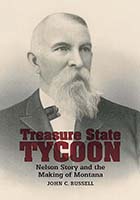
Ambitious, enterprising, and abusive, Nelson Story was an early Montana pioneer who made a fortune while making enemies and building the town of Bozeman. This biography covers the sweeping scope of Story’s exciting life, from his sojourn to Montana Territory in the 1860s with a Texas cattle drive and his savvy profiteering during the gold rush to his involvement in government contract fraud and his role in the development of Bozeman. A complex figure, Story possessed vision and entrepreneurial genius, but was also a ruthless businessman who was willing to resort to violence to achieve his goals.
paper, ISBN 978-1-94052-794-9, $19.95
The Turtle Who Went to War and Other Sioux Stories
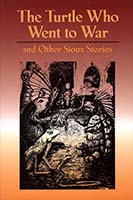
The Turtle Who Went to War includes five stories from the Indian Reading Series, a collection of authentic material cooperatively developed by Indigenous people. These traditional Sioux tales, originally designed to help educate young tribal members about their history and culture, include elements of friendship, bravery, loyalty and revenge. Recorded by Indigenous storytellers and illustrated by Indigenous artists, these entertaining stories are perfect for reluctant readers and offer a fascinating way for readers of all ages to learn about the Sioux. Co-published with Fort Peck Tribal Library.
Wheel Boats on the Missouri
edited by Richard E. Jensen and James S. Hutchins
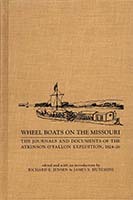
In 1824, Brigadier General Henry Atkinson and Indian Agent Benjamin O'Fallon traveled up the Missouri River, accompanied by 475 soldiers of the First and Sixth Infantry regiments. Their mission was to negotiate peace treaties with tribes along the Missouri River, and to secure these tribes' promise to trade exclusively with American traders. It was hoped this combination of military power and proffered friendship would put an end to Indian attacks on American fur trappers and traders. The full record of this early military expedition is now available in Wheel Boats on the Missouri. The journals of General Atkinson and Major Stephen Watts Kearny describe the trip from St. Louis to Fort Atkinson in the fall of 1824, the expedition from the fort to the Yellowstone River and back in 1825, and the return of a portion of the troops to St. Louis in 1826. In addition, the diary of Angus Lewis Langham, the expedition's secretary, describes the passage of the wheel boat Antelope from St. Louis to Fort Atkinson in early spring of 1825. This fully annotated volume also includes a discussion of the early use of the wheel boat to travel the Missouri River and the expedition's financial records.
